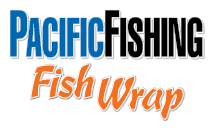The quota for Bering Sea pollock is likely to remain high next year based on the new stock assessment.
Government scientists are recommending an ABC (acceptable biological catch) of 2,800,000 metric tons, the highest level ever and well above this year's 2,090,000 tons.
The North Pacific Fishery Management Council will adopt the 2017 TAC (total allowable catch) at its December meeting in Anchorage.
For a number of reasons, the council typically sets a conservative TAC well below the ABC.
Based on the strong stock assessment, it appears the council will be free to set a TAC at least as high as this year's 1,340,000 tons.
Bering Sea pollock is Alaska's largest fishery by volume.
Monday, November 28, 2016
Wednesday, November 16, 2016
Bristol Bay catch projected lower in 2017
The Alaska Department of Fish and Game is forecasting a commercial catch of 27.5 million sockeye salmon next year at Bristol Bay.
Last season saw a harvest of 37.3 million sockeye.
Last season saw a harvest of 37.3 million sockeye.
Tuesday, November 15, 2016
Poor outlook for Upper Cook Inlet sockeye
The state's 2017 forecast projects a commercial harvest of 1.7 million sockeye in Upper Cook Inlet.
That would be 1.2 million fewer than the 20-year average, the forecast says.
That would be 1.2 million fewer than the 20-year average, the forecast says.
Monday, November 14, 2016
Some significant MSC news
Alaska's salmon fishery — with one big exception — is certified as well-managed and sustainable under the Marine Stewardship Council program.
The exception is Prince William Sound, a top salmon-producing region. The region lacks MSC certification due at least in part to questions about the impact of the Sound's large salmon hatcheries on wild fish stocks.
Now comes hope that Prince William Sound might soon achieve certification, joining the rest of the state's salmon fishery.
MRAG Americas, the company that certifies the Alaska salmon fishery to the MSC standard, recently issued an announcement that an MSC assessment of Prince William Sound salmon has begun.
The assessment, if favorable, could result in certification of the Prince William Sound salmon fishery in March 2017.
An assessment team is meeting in Juneau this week and will take up Prince William Sound on Wednesday, Amanda Stern-Pirlot, team leader for the assessment, tells Deckboss.
MSC certification is regarded as important for marketing Alaska salmon, particularly in Europe. Certification allows producers to label their product with the blue MSC ecolabel.
The Prince William Sound assessment comes at the request of the Pacific Seafood Processors Association, the Seattle-based trade group that holds the MSC certificate for the Alaska salmon fishery.
The exception is Prince William Sound, a top salmon-producing region. The region lacks MSC certification due at least in part to questions about the impact of the Sound's large salmon hatcheries on wild fish stocks.
Now comes hope that Prince William Sound might soon achieve certification, joining the rest of the state's salmon fishery.
MRAG Americas, the company that certifies the Alaska salmon fishery to the MSC standard, recently issued an announcement that an MSC assessment of Prince William Sound salmon has begun.
The assessment, if favorable, could result in certification of the Prince William Sound salmon fishery in March 2017.
An assessment team is meeting in Juneau this week and will take up Prince William Sound on Wednesday, Amanda Stern-Pirlot, team leader for the assessment, tells Deckboss.
MSC certification is regarded as important for marketing Alaska salmon, particularly in Europe. Certification allows producers to label their product with the blue MSC ecolabel.
The Prince William Sound assessment comes at the request of the Pacific Seafood Processors Association, the Seattle-based trade group that holds the MSC certificate for the Alaska salmon fishery.
Tuesday, November 8, 2016
Another Southeast seine buyback?
Here's a federal notice indicating Southeast Alaska salmon seine permit holders soon will vote on whether to shoulder a $5.8 million loan to retire 22 permits from the fishery.
The voting period starts Dec. 13, the notice says.
In 2012, Southeast seiners approved a $13.1 million loan to remove 64 permits.
Currently, there are 315 permits in the fishery.
The voting period starts Dec. 13, the notice says.
In 2012, Southeast seiners approved a $13.1 million loan to remove 64 permits.
Currently, there are 315 permits in the fishery.
Monday, November 7, 2016
Strong outlook for Southeast pink salmon
The state is forecasting a strong harvest of 43 million pink salmon next year in Southeast Alaska.
That would be a big rebound from this year's poor catch of 18.3 million pinks in Southeast.
That would be a big rebound from this year's poor catch of 18.3 million pinks in Southeast.
Subscribe to:
Posts (Atom)


